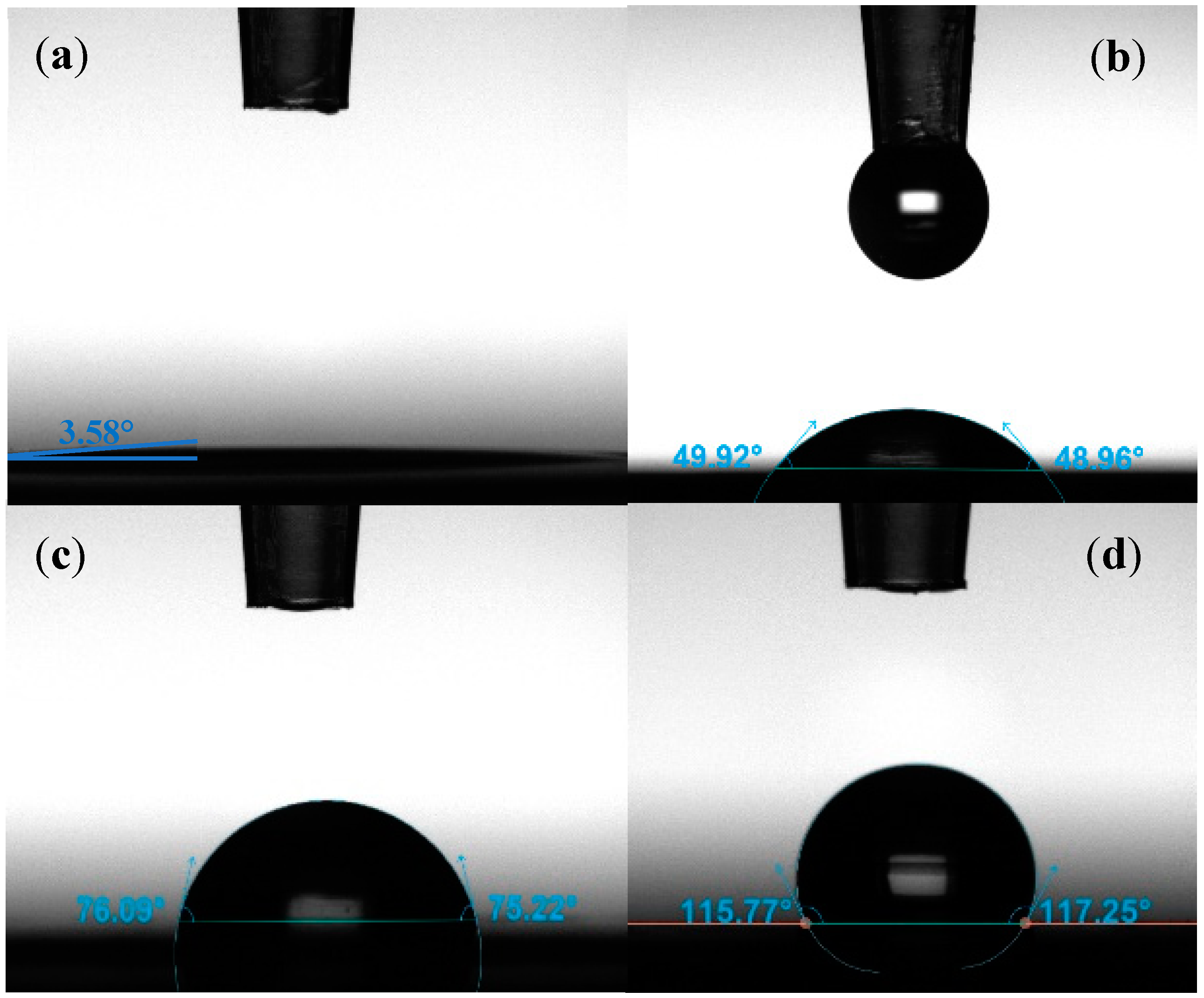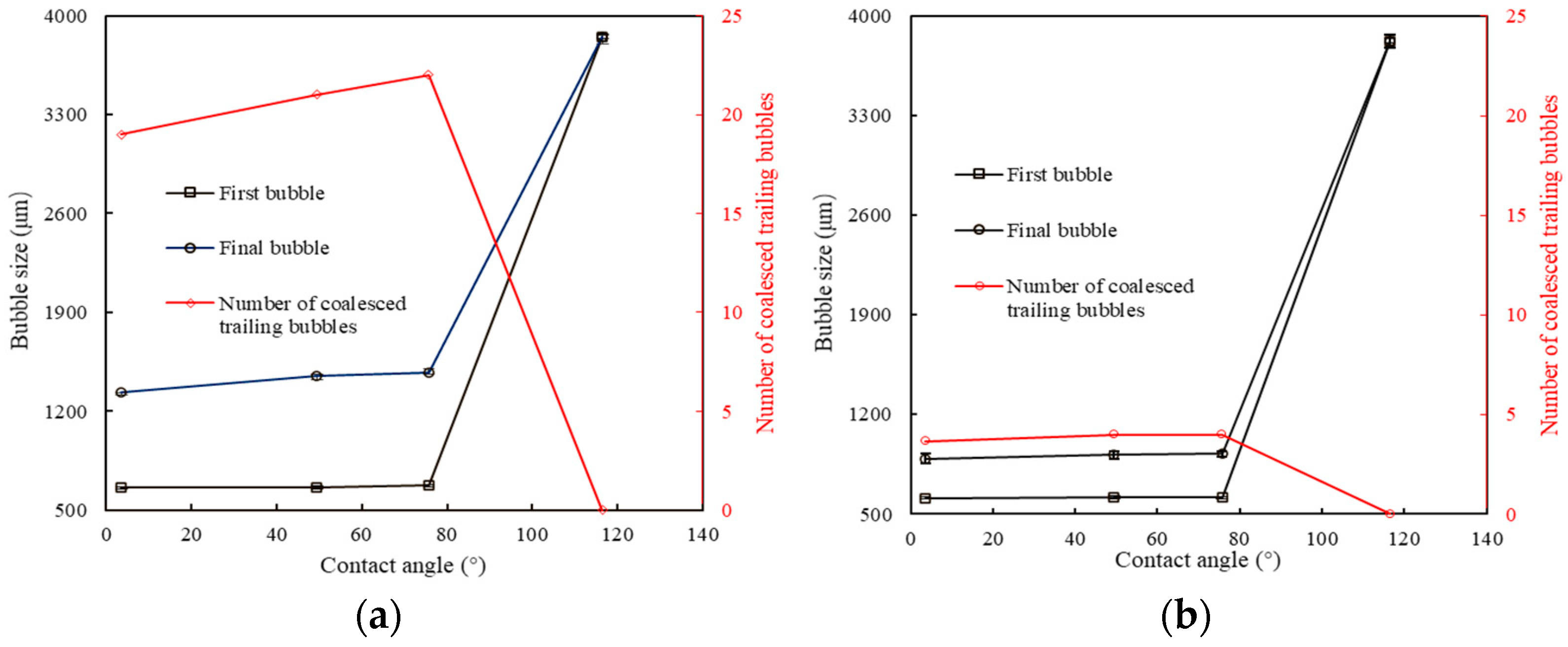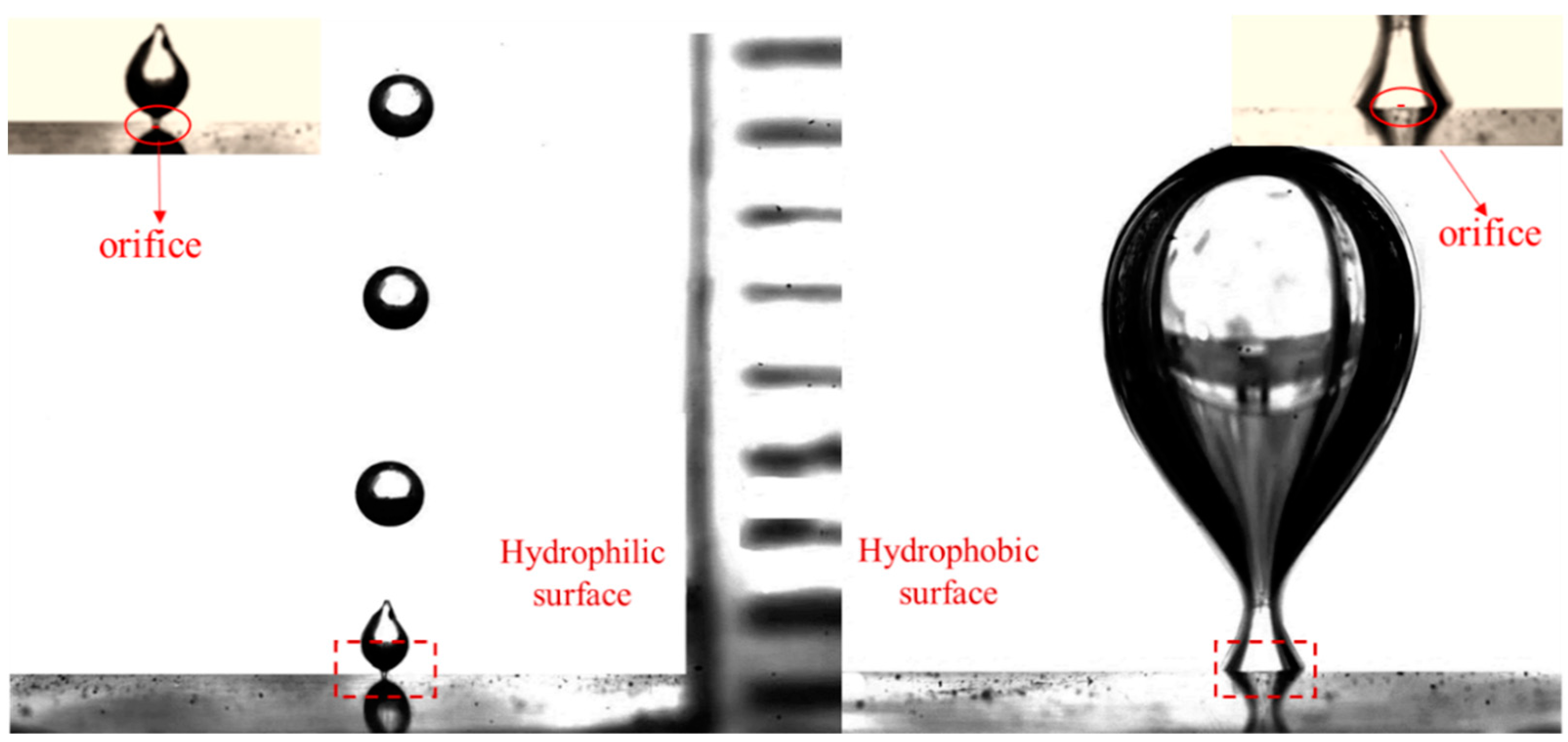Effect of Sparger Characteristics on Bubble-Formation Dynamics under Oscillatory Air Pattern
Abstract
:1. Introduction
2. Experimental Setup and Methods
2.1. Materials and Experimental Setup
2.2. Experimental Procedure
3. Results and Discussion
3.1. Plate Surface Wettability
3.2. Chamber Volume
3.3. Plate Thickness
4. Conclusions
- An oscillatory air pattern could significantly decrease bubble size when a hydrophilic plate was used. However, its influence on bubble formation was offset by the increased restraining force resulting from the enlarged contact rim of bubbles with the plate when a hydrophobic surface was applied.
- Bubble size and the number of coalesced trailing bubbles were positively related to the chamber volume under an oscillatory air state. A small chamber volume was preferred to maintain a constant flow condition to fully use the enhanced momentum force for bubble detachment.
- A nonlinear relationship existed between the plate thickness and the bubble size. An appropriate thickness could not only avoid the weeping phenomenon but also reduce energy dissipation caused by capillary resistance. Therefore, the suitable plate thickness should be selected under an oscillatory air pattern.
Author Contributions
Funding
Conflicts of Interest
References
- Khalili, F.; Nasr, M.R.J.; Kazemzadeh, A.; Ein-Mozaffari, F. Analysis of gas holdup and bubble behavior in a biopolymer solution inside a bioreactor using tomography and dynamic gas disengagement techniques. J. Chem. Technol. Biotechnol. 2018, 93, 340–349. [Google Scholar] [CrossRef]
- Maske, S.K.; Rai, D.S.; Kale, V.S.; Raut, B.D.; Chintale, G.A. Microbubble and its applications. Int. J. Pharm. Life Sci. 2012, 3, 2228–2235. [Google Scholar]
- Zhou, F.; Wang, L.; Xu, Z.; Ruan, Y.; Chi, R. A study on novel reactive oily bubble technology enhanced collophane flotation. Int. J. Miner. Process. 2017, 169, 85–90. [Google Scholar] [CrossRef]
- Li, C.; Wang, L. Improved froth zone and collection zone recoveries of fine mineral particles in a flotation column with oscillatory air supply. Sep. Purif. Technol. 2018, 193, 311–316. [Google Scholar] [CrossRef] [Green Version]
- Li, C.; Dong, L.; Wang, L. Improvement of flotation recovery using oscillatory air supply. Miner. Eng. 2019, 131, 321–324. [Google Scholar] [CrossRef]
- Cao, B.; Fan, J.; Sun, X.; Li, S. Numerical Simulation of Mass-Transfer Characteristics of a Bubble Rising in Yield Stress Fluids. ACS Omega 2020, 5, 13878–13885. [Google Scholar] [CrossRef]
- Jamialahmadi, M.; Zehtaban, M.R.; Müller-Steinhagen, H.; Sarrafi, A.; Smith, J.M. Study of Bubble Formation under Constant Flow Conditions. Chem. Eng. Res. Des. 2001, 79, 523–532. [Google Scholar] [CrossRef]
- Peng, W.L.; Yang, G.Q.; Fan, L.S. Experimental studies of liquid weeping and bubbling phenomena at submerged orifices. Ind. Eng. Chem. Res. 2002, 41, 1666–1677. [Google Scholar] [CrossRef]
- Kulkarni, A.A. Effect of Sparger Design on the Local Flow Field in a Bubble Column. Chem. Eng. Res. Des. 2005, 83, 59–66. [Google Scholar] [CrossRef]
- Thorat, B.N.; Kulkarni, A.V.; Joshi, J.B. Design of sieve plate spargers for bubble columns: Role of weeping. Chem. Eng. Technol. 2001, 24, 815–828. [Google Scholar] [CrossRef]
- Shi, H.; Jiang, H.; Liu, Y.; Chen, R. Bubble dynamics and mass transfer characteristics from an immersed orifice plate. J. Chem. Technol. Biotechnol. 2020, 95, 1729–1738. [Google Scholar] [CrossRef]
- Song, A.; Ji, Y.; Li, C.; Cao, Y. Modeling and validation of the momentum force for bubble formation from submerged orifices with an oscillatory air supply. Chem. Eng. Sci. 2021, 233, 116387. [Google Scholar] [CrossRef]
- Zimmerman, W.B.; Tesar, V.; Butler, S.; Bandulasena, H.H. Microbubble generation. Recent Pat. Eng. 2008, 2, 1–8. [Google Scholar] [CrossRef] [Green Version]
- Tesař, V. Microbubble smallness limited by conjunctions. Chem. Eng. J. 2013, 231, 526–536. [Google Scholar] [CrossRef]
- Song, A.; Zhao, S.; Li, C.; Cao, Y. A Quantitative Study on the Decreased Diameter of Bubbles Generated from a Submerged Orifice with an Oscillatory Air Supply. Ind. Eng. Chem. Res. 2022, 61, 3113–3122. [Google Scholar] [CrossRef]
- Kulkarni, A.V.; Badgandi, S.V.; Joshi, J.B. Design of ring and spider type spargers for bubble column reactor: Experimental measurements and CFD simulation of flow and weeping. Chem. Eng. Res. Des. 2009, 87, 1612–1630. [Google Scholar] [CrossRef]
- Xing, X.; Zhang, C.; Jiang, B.; Sun, Y.; Zhang, L.; Briens, C. Numerical study of the effect of the inlet gas distributor on the bubble distribution in a bubbling fluidized bed. Chem. Eng. Res. Des. 2022, 177, 70–82. [Google Scholar] [CrossRef]
- Bari, S.D.; Robinson, A.J. Experimental study of gas injected bubble growth from submerged orifices. Exp. Therm. Fluid Sci. 2013, 44, 124–137. [Google Scholar] [CrossRef] [Green Version]
- Bae, K.; Kim, J.Y.; Go, K.S.; Nho, N.S.; Kim, D.; Bae, J.W.; Lee, D. Effect of distributor type on microbubble dispersion in a pressurized bubble column. Chem. Eng. Res. Des. 2021, 174, 188–198. [Google Scholar] [CrossRef]
- Stanovsky, P.; Ruzicka, M.C.; Martins, A.; Teixeira, J.A. Meniscus dynamics in bubble formation: A parametric study. Chem. Eng. Sci. 2011, 66, 3258–3267. [Google Scholar] [CrossRef] [Green Version]
- Corchero, G.; Medina, A.; Higuera, F.J. Effect of wetting conditions and flow rate on bubble formation at orifices submerged in water. Colloids Surf. A Physicochem. Eng. Asp. 2006, 290, 41–49. [Google Scholar] [CrossRef]
- Gokhale, O.S.; Jog, M.A.; Manglik, R.M. Experimental study of chamber volume effect on bubble formation from orifice plates submerged in water. Int. Mech. Eng. Congr. Expo. 2018, 9, 9–15. [Google Scholar]
- Ji, Y.; Song, A.; Li, C.; Cao, Y. Role of Sparger Configuration in Determining Flotation Performance under Oscillatory Air Supply. Processes 2021, 9, 638. [Google Scholar] [CrossRef]
- Gourram-Badri, F.; Conil, G.M.P. Measurements of selectivity due to coalescence between two mineralized bubbles and characterization of MIBC action on froth flotation. Int. J. Miner. Process. 1997, 51, 197–208. [Google Scholar] [CrossRef]
- Yu, X.X.; Wang, Y.W.; Huang, C.G.; Du, T.Z. Three stages of bubble formation on submerged orifice under constant gas flow rate. J. Phys. Conf. Ser. 2015, 656, 012042–012045. [Google Scholar] [CrossRef]
- Wen, J.; Sun, Q.; Sun, Z.; Gu, H. The effect of multi-orifice plate configuration on bubble detachment volume. Chin. J. Chem. Eng. 2019, 27, 72–84. [Google Scholar] [CrossRef]
- Fan, W.; Yin, X. Bubble formation in shear-thinning fluids: Laser image measurement and a novel correlation for detached volume. Chem. Ind. Chem. Eng. Q. 2017, 23, 301–309. [Google Scholar] [CrossRef]
- Zhang, W.X.; Tan, R.B.H. Bubble emission frequency and weeping rate at a submerged orifice with bulk liquid flow. Can. J. Chem. Eng. 2003, 81, 465–469. [Google Scholar] [CrossRef]
- Wen, J.; Tian, R.; Tan, S.; Sun, Q.; Gu, H. The weeping characteristic of submerged multi-orifice plate. Chin. J. Chem. Eng. 2020, 28, 955–968. [Google Scholar] [CrossRef]








Publisher’s Note: MDPI stays neutral with regard to jurisdictional claims in published maps and institutional affiliations. |
© 2022 by the authors. Licensee MDPI, Basel, Switzerland. This article is an open access article distributed under the terms and conditions of the Creative Commons Attribution (CC BY) license (https://creativecommons.org/licenses/by/4.0/).
Share and Cite
Song, A.; Zhao, S.; Cao, Y.; Li, C. Effect of Sparger Characteristics on Bubble-Formation Dynamics under Oscillatory Air Pattern. Processes 2022, 10, 997. https://doi.org/10.3390/pr10050997
Song A, Zhao S, Cao Y, Li C. Effect of Sparger Characteristics on Bubble-Formation Dynamics under Oscillatory Air Pattern. Processes. 2022; 10(5):997. https://doi.org/10.3390/pr10050997
Chicago/Turabian StyleSong, Ajuan, Sijia Zhao, Yijun Cao, and Chao Li. 2022. "Effect of Sparger Characteristics on Bubble-Formation Dynamics under Oscillatory Air Pattern" Processes 10, no. 5: 997. https://doi.org/10.3390/pr10050997
APA StyleSong, A., Zhao, S., Cao, Y., & Li, C. (2022). Effect of Sparger Characteristics on Bubble-Formation Dynamics under Oscillatory Air Pattern. Processes, 10(5), 997. https://doi.org/10.3390/pr10050997







